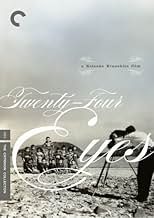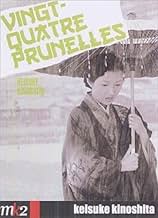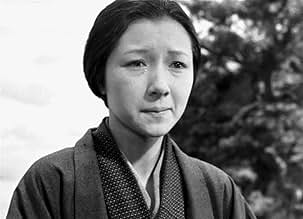AVALIAÇÃO DA IMDb
8,0/10
3 mil
SUA AVALIAÇÃO
A professora Hisako Oishi cria um vínculo emocional com seus alunos e lhes ensina várias virtudes, ao mesmo tempo em que se preocupa com o futuro deles.A professora Hisako Oishi cria um vínculo emocional com seus alunos e lhes ensina várias virtudes, ao mesmo tempo em que se preocupa com o futuro deles.A professora Hisako Oishi cria um vínculo emocional com seus alunos e lhes ensina várias virtudes, ao mesmo tempo em que se preocupa com o futuro deles.
- Prêmios
- 10 vitórias e 1 indicação no total
- Direção
- Roteiristas
- Elenco e equipe completos
- Produção, bilheteria e muito mais no IMDbPro
Enredo
Você sabia?
- CuriosidadesAccording to Japanese film critic and historian Tadao Satô, in casting this film about a schoolteacher and her relationships with her pupils over many years, director Keisuke Kinoshita very cleverly chose pairs of look-alike siblings to portray the students. So for those scenes set in later years, Kinoshita simply substituted the older siblings for the younger ones, so that the schoolchildren appeared to "grow" before the audience's eyes.
- ConexõesReferenced in Violência ao meio Dia (1966)
- Trilhas sonorasAnnie Laurie
Avaliação em destaque
Considered by some Japanese critics as one of the ten best Japanese films of all time, Keisuke Kinoshita's Twenty-Four Eyes is a moving tribute to a teacher's dedication to her students and to her progressive ideals. The film spans twenty years of turbulent Japanese history beginning in 1928 and continuing through the end of World War II. Though to Western eyes it can be at times oppressively melodramatic with its overuse of such sentimental melodies like "Annie Laurie", "Auld Lang Syne", and "Bless This House", the film was extremely popular in Japan, beating out such highly regarded classics as Mizoguchi's Sansho Dayu, Kurosawa's Seven Samurai, and Naruse's Late Chrysanthemums for Best Film in Japan and Best Foreign Film at the Golden Globes.
Adapted from a novel by Sakae Tsuboi and set in the rural island of Shodoshima, the title refers to the eyes of seven girls and five boys, the twelve students of first grade teacher Hisako Oishi (Hideko Takamine), endearingly called "Miss Pebble". As the film opens, a confident new teacher, Miss Oishi, rides to the school on her bicycle dressed in modern Western clothes but soon has problems being accepted by the working class villagers who think that she is a wealthy outsider. The senior teacher (Chishu Ryu) at the primary school even asks why the authorities would send such a good teacher. Miss Oishi is also criticized for calling the students by their nicknames, inquiring into each child's family life, and singing folk songs instead of the school anthems.
Later, during the Japanese invasion of China, she is suspected of being a "red" because she discourages her young pupils from becoming soldiers but does not protest when the headmaster burns one of her books. Proud but traditionally passive, she refuses to intervene in a family dispute when one of her students, a gifted singer, expresses a desire to attend the conservatory rather than go to work in a café, and does not attempt to raise funds to send one of the poorest students on a school trip. Miss Oishi is able to gain a share of acceptance, however, after an injury to her leg sidelines her for several months and the children visit her without being aware of the length of the journey. It is only when she meets the crying children on their way to her home that reconciliation with the community begins to take place.
Unfortunately, the length of the trip to the school forces Miss Oishi to transfer to the middle school closer to her home and she will not teach the same children for five years. Miss Oishi is a compassionate teacher who does not want to see her bright young students killed in the war but the growing conflict in China and the increasing poverty in the village force the young men to become cannon fodder for the militarists with unfortunate results. Twenty-Four Eyes to our modern view has many excesses including its almost three-hour length but the purity and radiance of Takamine as the compassionate school teacher shines through and the film allowed Japanese audiences to experience a cathartic expression of the sadness and loss caused by the war.
Adapted from a novel by Sakae Tsuboi and set in the rural island of Shodoshima, the title refers to the eyes of seven girls and five boys, the twelve students of first grade teacher Hisako Oishi (Hideko Takamine), endearingly called "Miss Pebble". As the film opens, a confident new teacher, Miss Oishi, rides to the school on her bicycle dressed in modern Western clothes but soon has problems being accepted by the working class villagers who think that she is a wealthy outsider. The senior teacher (Chishu Ryu) at the primary school even asks why the authorities would send such a good teacher. Miss Oishi is also criticized for calling the students by their nicknames, inquiring into each child's family life, and singing folk songs instead of the school anthems.
Later, during the Japanese invasion of China, she is suspected of being a "red" because she discourages her young pupils from becoming soldiers but does not protest when the headmaster burns one of her books. Proud but traditionally passive, she refuses to intervene in a family dispute when one of her students, a gifted singer, expresses a desire to attend the conservatory rather than go to work in a café, and does not attempt to raise funds to send one of the poorest students on a school trip. Miss Oishi is able to gain a share of acceptance, however, after an injury to her leg sidelines her for several months and the children visit her without being aware of the length of the journey. It is only when she meets the crying children on their way to her home that reconciliation with the community begins to take place.
Unfortunately, the length of the trip to the school forces Miss Oishi to transfer to the middle school closer to her home and she will not teach the same children for five years. Miss Oishi is a compassionate teacher who does not want to see her bright young students killed in the war but the growing conflict in China and the increasing poverty in the village force the young men to become cannon fodder for the militarists with unfortunate results. Twenty-Four Eyes to our modern view has many excesses including its almost three-hour length but the purity and radiance of Takamine as the compassionate school teacher shines through and the film allowed Japanese audiences to experience a cathartic expression of the sadness and loss caused by the war.
- howard.schumann
- 25 de ago. de 2008
- Link permanente
Principais escolhas
Faça login para avaliar e ver a lista de recomendações personalizadas
- How long is Twenty-Four Eyes?Fornecido pela Alexa
Detalhes
- Tempo de duração2 horas 36 minutos
- Cor
- Mixagem de som
- Proporção
- 1.37 : 1
Contribua para esta página
Sugerir uma alteração ou adicionar conteúdo ausente























